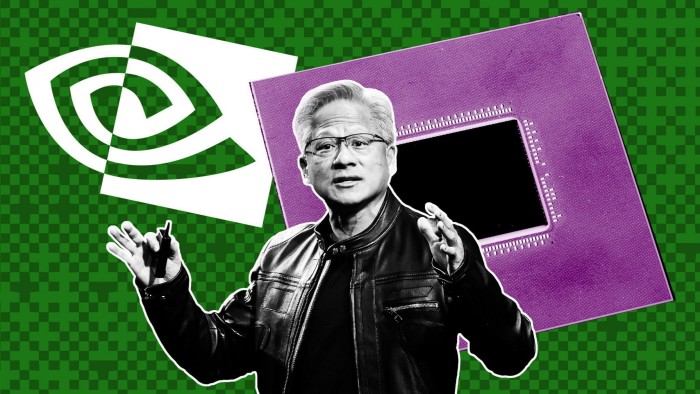Unlock the Editor’s Digest for free
Roula Khalaf, Editor of the FT, selects her favourite stories in this weekly newsletter.
Nvidia reported another quarter of strong growth on Wednesday in the face of markets jitters about how its China chip business will navigate geopolitical tensions between Washington and Beijing.
The $4tn tech giant at the heart of the AI boom said its revenue was $46.7bn for the quarter to July 28, up 56 per cent year on year and slightly above consensus estimates of $46.5bn, according to Visible Alpha.
Nvidia said it expected $54bn in sales for the current quarter, plus or minus 2 per cent, compared with expectations of $53.8bn.
The company’s role in designing the advanced chips that are used to develop and run AI models such as ChatGPT has propelled it to become the world’s most valuable group by market capitalisation and made it a bellwether for the AI boom.
But the company has become embroiled in US President Donald Trump’s trade war with Beijing.
Analysts said Nvidia’s decision not to include China AI chip revenue in its outlook disappointed investors after it cut a deal with the Trump administration to resume sales of the H20 chip, which Nvidia designed for the Chinese market
Shares were down about 2.5 per cent in after-hours trading on Wednesday.
Gene Munster, managing partner at Deepwater Asset Management, said excluding China meant Nvidia’s guidance was lower than what some had expected.
“That $54bn doesn’t include the H20 — and I was shocked that they didn’t,” he said. Many Wall Street revenue estimates had factored in about $2bn in additional revenue for the current quarter after the export restrictions were lifted, he added.
The state of Nvidia’s China business is a crucial question for investors.
New export controls imposed earlier this year by the Trump administration on H20 chips wiped out its sales. Nvidia earlier this month reached an agreement with the US government to pay a 15 per cent cut in return for a licence to resume sales in China.
Nvidia warned in an earnings filing that the deal could “subject us to litigation, increase our costs, and harm our competitive position”. Rival AMD has struck a similar deal.
Beijing has also pushed back against Chinese companies using Nvidia chips, leaving analysts with little visibility into how much the company will sell this year as wider trade negotiations between Washington and Beijing drag on.
Nvidia chief financial officer Colette Kress told analysts on Wednesday that the company was still waiting on the US government to publish a “regulation” codifying the deal struck earlier this month.
If such geopolitical issues resolve, Nvidia could ship between $2bn and $5bn of its H20 chips to China during the quarter, Kress said, with a “select number” of Chinese customers already receiving licences in recent weeks.
It said that despite no H20 revenue from China during the quarter due to new US export controls, it had managed to sell $650mn of its China-specific H20 chips to a customer outside of the country.
Nvidia’s revenue from customers whose billing location is in China, which includes sales of its gaming chips, fell by 50 per cent from the previous quarter and was down 25 per cent year on year, to $2.8bn.
Global data centre revenue, which relates to Nvidia’s AI chip business, was $41.1bn, slightly under consensus estimates of $41.4bn. The slip was offset by better than expected revenue from its gaming segment.
Nvidia’s stock has surged 35 per cent this year as of Wednesday’s close, helping drive gains in the broader market. But it has proved sensitive to any negative news.

The shares took a hit last week during a widespread sell-off in companies linked to AI, after a negative report on its practical applications and comments by OpenAI chief executive Sam Altman about investors overhyping the technology.
Net income jumped 59 per cent from last year to $26.4bn, against forecasts of $23.5bn. Earnings per share were $1.08, while adjusted gross margin was 72.7 per cent, slightly above consensus estimates of 72.3 per cent.
Recommended
The rollout of the company’s latest Blackwell platform, Blackwell Ultra, was “ramping at full speed, and demand is extraordinary”, said Nvidia chief executive Jensen Huang.
The deployment of the new hardware involves more complex infrastructure to build its chips into ever-larger racks of interconnected chips, and hit technical snags early in its development.
Nvidia is working on a new chip based on Blackwell for the China market, that is more powerful than the H20 but still not as capable as its most advanced US chips. Trump has indicated that he is open to a similar revenue deal.


